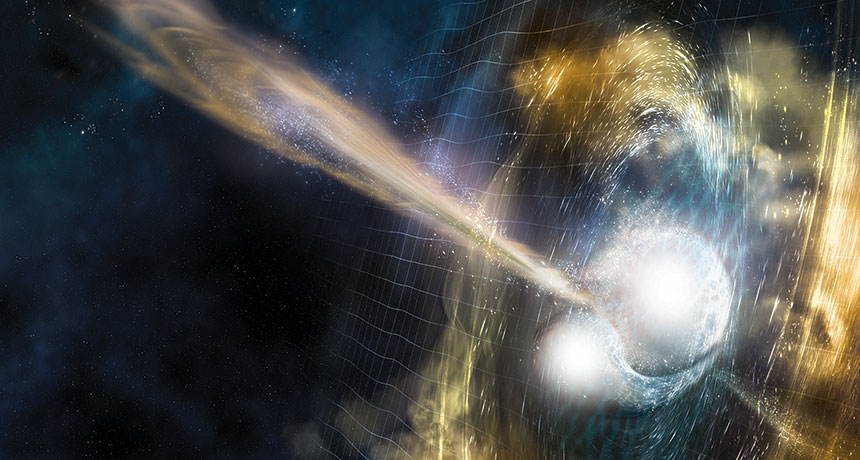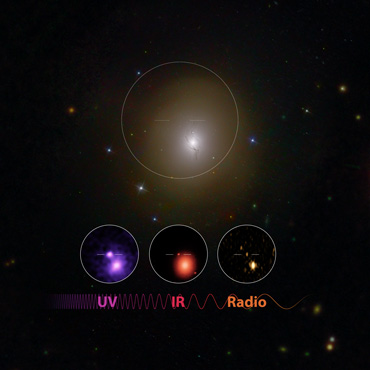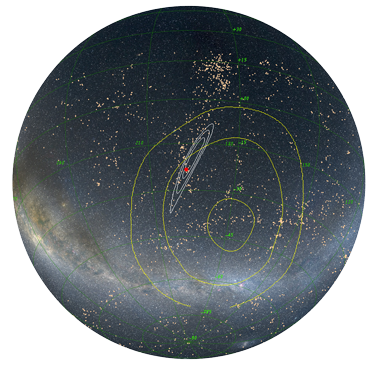Neutron star collision showers the universe with a wealth of discoveries
Detection of gravitational waves from smashup helps reveal where heavy elements are created

BRIGHT BURST After two neutron stars slammed together, scientists detected gravitational waves, a burst of gamma rays and a glow from ejected material, shown in this artist’s conception.
NSF, LIGO, A. Simonnet/Sonoma State Univ.
WASHINGTON — Two ultradense cores of dead stars have produced a long-awaited cosmic collision, showering scientists with riches.
The event was the first direct sighting of a smashup of neutron stars, which are formed when aging stars explode and leave behind a neutron-rich remnant. In the wake of the collision, the churning residue forged gold, silver, platinum and a smattering of other heavy elements such as uranium, researchers reported October 16 at a news conference in Washington, D.C. Such elements’ birthplaces were previously unknown, but their origins were revealed by the cataclysm’s afterglow.
“It really is the last missing piece” of the periodic table, says Anna Frebel, an astronomer at MIT who was not involved in the research. “This is heaven for anyone working in the field.” After the collision, about 10 times the Earth’s mass in gold was spewed out into space, some scientists calculated.
Using data gathered by about 70 different observatories, astronomers characterized the event in exquisite detail, releasing a slew of papers describing the results. A tremor of gravitational waves, spotted by the Advanced Laser Interferometer Gravitational-Wave Observatory, LIGO, on August 17, provided the first sign of the cataclysm.
“Already it is transforming our understanding of the universe, with a fresh narrative of the physics of stars in their death throes,” said France Córdova, director of the National Science Foundation, which funds LIGO.
A sequence of various types of electromagnetic radiation followed that gravitational trill, like musical instruments taking turns in a symphony. A burst of gamma rays segued into a glow of visible and infrared light, first spotted about 12 hours after the smashup. More than a week later, as those wavelengths faded away, X-rays crescendoed, followed by radio waves.
Combining gravitational waves with light from a neutron star merger is a long-held dream of astrophysicists. “The picture that you can put together by having all of those sources is synergistic,” says LIGO spokesperson David Shoemaker of MIT. “You can make inferences that otherwise would be impossible.”
That detailed picture revealed the inner workings of neutron star collisions and the source of brief blasts of high-energy light called short gamma-ray bursts. Researchers also calculated how fast the universe is expanding and tested the properties of the odd material within neutron stars.
For astrophysicists, “this event is the Rosetta stone,” says LIGO member Richard O’Shaughnessy of the Rochester Institute of Technology in New York.
LIGO’s two detectors, located in the United States, registered an unmistakable sign of the upheaval: A shimmying of space itself that continued for about 100 seconds before cutting off. It was the strongest and longest series of spacetime ripples LIGO had ever seen. At that point, scientists knew they had something big, says LIGO member Vicky Kalogera of Northwestern University in Evanston, Ill. “The e-mails that were circulated said, ‘Oh my God, this is it.’”
That vibration was an indication of a cosmic crash: Whirling round each other as if on an ill-fated merry-go-round, two orbiting neutron stars spiraled closer and closer, until they converged. The neutron stars, whose masses were between 1.17 and 1.60 times that of the sun, probably collapsed into a black hole, although LIGO scientists were unable to determine the stars’ fate for certain. LIGO has previously spotted mergers of swirling black holes with masses tens of times that of the sun (SN Online: 9/27/17); the smaller masses of the orbiting duo pointed the finger at neutron stars. And because black holes aren’t expected to emit light, the fireworks show that followed solidified the case for neutron stars.
LIGO’s sister experiment in Italy, Advanced Virgo, saw only a faint signal. That relatively weak detection helped narrow down where the convulsion occurred to “a part of the sky that was a blind spot of Virgo,” Kalogera says. That constrained the site to within a region of about 30 square degrees in the southern sky.
Just 1.7 seconds after the gravitational wave signal, NASA’s Fermi space telescope spotted a glimmer of gamma rays in the same neighborhood of the sky. Meanwhile, other telescopes swung into action, picking up a glow where none had been before. “We saw what looked like a new star,” says astronomer Edo Berger of Harvard University, who led a team that spotted the light with the DECam on the Blanco telescope in Chile. Berger’s was one of several teams that observed the blast’s light. That detection pinpointed the galaxy NGC 4993, 130 million light-years from Earth in the constellation Hydra, as the collision site. “There was this moment of disbelief: Wow, we actually did it. We found it,” Berger says.
Story continues below graphic
That afterglow also revealed an amazing story of stellar alchemy: With the stars’ death came the birth of elements. As the collision spurted neutron-rich material into space, a bevy of heavy elements formed, through a chain of reactions called the r-process (SN: 5/14/16, p. 9). In this process, which requires an environment crammed with neutrons, atomic nuclei rapidly gobble up neutrons and decay radioactively, thereby transforming into new elements, before resuming their neutron gorgefest. The r-process is thought to produce about half of the elements heavier than iron.
Scientists detected the characteristic glow of this process, called a kilonova, in follow-up observations. “Until this event, we had never directly seen anywhere in nature these heavy elements being forged. Now we have,” says Brian Metzger, a theoretical astrophysicist at Columbia University. “It is a feeling like you’ve discovered some kind of secret of nature.”
Previously, astrophysicists disagreed about where the r-process occurs: Two top candidates were exploding stars called supernovas (SN: 2/18/17, p. 24) and neutron star mergers. Although scientists can’t yet say whether all r-process elements are produced in neutron star mergers, the amount such collisions should produce appears large enough to explain the abundances found in the universe.
Story continues below graphic
Additional riches were revealed by gamma rays. Scientists spotted a phenomenon called a short gamma-ray burst, a brief spurt of high-energy light, less than two seconds long. Such paroxysms are relatively common, appearing in the sky about 50 times a year. But finding their source is “a long-standing problem in astrophysics,” says theoretical astrophysicist Rosalba Perna of Stony Brook University in New York. The detection clinched it: Short gamma-ray bursts come from neutron star tête-à-têtes.
By studying how the neutron stars spiraled inward, astrophysicists also tested the “squishiness” of neutron star material for the first time. This extreme substance is so dense that a teaspoonful of it would have a mass of around a billion metric tons, and scientists don’t fully understand how it responds when squeezed, a property known as its “equation of state.” Measuring this property could give scientists a better understanding of the strange material. Although the results couldn’t pin down whether the neutron stars were squishy, some theories that predicted ultrasquishy neutron stars were ruled out.
The neutron stars’ union also gave researchers the opportunity to gauge the universe’s expansion rate, by measuring the distance of the collision using gravitational waves and comparing that to how much the wavelength of light from the galaxy was stretched by the expansion. Scientists have previously measured this property, known as the Hubble constant, through other means. But those measurements are in disagreement, leaving scientists scrambling to explain the discrepancy (SN: 8/6/16, p. 10).
Now, scientists have “a totally different, independent measurement,” says LIGO collaboration member Daniel Holz of the University of Chicago. The new measurement indicates that distantly separated galaxies are spreading apart at about 70 kilometers per second for each megaparsec between them. It falls squarely between the two previous estimates: 67 and 73 km/s per megaparsec. Though this collision can’t yet resolve the debate, future mergers could help improve the measurement.
“These are all just unbelievable, major advances,” Holz says. “It’s really been this insane thrill.”
The excitement has yet to die down. Take it from astronomer Ryan Foley of the University of California, Santa Cruz, whose team was the first to spot visible light from the merger: “This is certainly the biggest discovery of my career and probably will be the biggest discovery of my entire life.”
Researchers announced October 16 that Advanced LIGO (the Laser Interferometer Gravitational-Wave Observatory) and its sister experiment, Advanced Virgo, have detected gravitational waves from colliding neutron stars — a cosmic crash also observed by more than 70 observatories around the world. H. Thompson/Science News/YouTube |
Editor’s note: This story will be updated throughout the day as more information becomes available.









